A real war criminal
War crimes trial -and three
assassinations
|
|
Car bombs |
|
Arik Scheiderman |

|
Elie Hobieka |
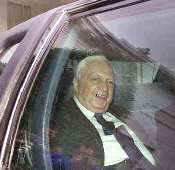
|
|
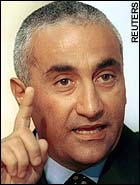
|
|
| This site covers the 'War crime' and the assassination
of the three people who were about to testify. How their families were also maimed
and killed. The message Israel sent -You talk and your family
dies |
Summary |
| In 1982 the Jewish warlord (Ariel Scheiderman aka Ariel Sharon)
invaded Beirut to kill the PLO. During the invasion 20,000 innocent Lebonese were
killed. Reagan talked the PLO into fleeing to Tunisa but their families stayed in refugee
camps (Sabra and Chantila). Sharon sent in a Israeli proxy (Phalange Militia) who killed
the PLO families - 3500. In 2001 a Belgium court decided to prosecute the' Butcher of
Sabra' - Sharon. Before the trial could begin the three main witnesses against Sharon were
assassinated.
- ELIE HOBEIKA: ------ The explosives, in a parked Mercedes, demolished Hobeika's Range Rover as it
drove by. Three other people in the car including two bodyguards, were killed. The
immediate area was filled with wrecked cars and burning buildings.
- Mr Ghanem: ------ once Hobeika's political deputy, died
only four days before Hobeika.is rumoured to have held documents that his former boss
intended to present to Belgian lawyers in their attempt to indict Mr Sharon for his
involvement in the massacre in which up to 1,700
Palestinian civilians were killed. But on New Year's Day, Mr Ghanem, who was only 56 and
with no history of heart problems, drove his car into a tree in the suburb of Hazmieh
– only a few hundred metres from the spot where Hobeika was killed by a car bomb last
week.
- Michael Nassar: -----A former associate of Elie Hobeika
– the Phalangist leader murdered in a car bombing in Beirut in January – was shot dead in Brazil by a man firing a pistol equipped with a silencer.
His young wife, Marie, was shot down beside him.
The secrets of the Sabra and
Chatila Palestinian camp massacres in 1982 have gone to the grave with yet another former
Phalangist militiaman, the third Lebanese to die mysteriously in little more than two
months.
Ariel Schiederman aka
Ariel Sharon ---- A insult to humanity
|
The Massacre of Sabra and Shatila in 1982 |
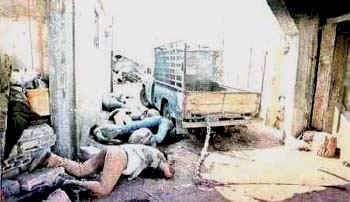
|
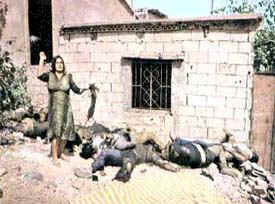 |
|
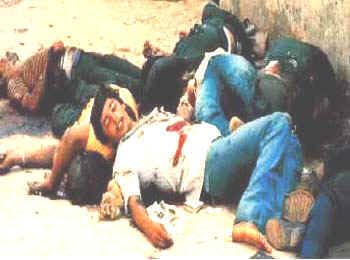 |
|
|
|
The Sabra and Chatila massacre is one of the most barbarous events in
recent history. Thousands of unarmed and defenseless Palestinian refugees-- old men, women
and children-- were butchered in an orgy of savage killing. On December 16, 1982 the
United Nations General Assembly condemned the massacre and declared it to be an act of
genocide.
Ronald Reagan

"Jewish Hollywood creation" |
Reagan arranged a ceasefire between Israel and the PLO, and promised to protect
Palestinian civilians after the withdrawal of PLO fighters to Tunisia.
Soon after, Israel's principal Lebanese ally, Phalangist warlord Bashir Gemayel, was
blown to bits by a bomb, likely planted by Israeli Mossad.
This light the fire for the massacre.
|
On the evening of Sept. 16, 1982, Israeli troops surrounded the Palestinian refugee
camps of Shatilla and Sabra. Sharon allowed - some allege he ordered - the Phalangist
fighters to enter the undefended camps.
If that wasn't enough - Reagan ordered the USS Battleship - New Jersey to shell Beirut
|
In June 1982, Israel again invaded the rest of Lebanon. In
operation "Peace for Galilee" Israeli forces bombed
and besieged Beirut for two months until Palestine Liberation Organisation leaders agreed
to leave the city. An estimated 18,000 people were killed and 30, 000 injured.
Background of the massacre
The Sabra and Chatila massacre was an outcome of the alliance between Israel and
the Lebanese Phalangists. In its long-standing war against Palestinian nationalism and
against the Palestine Liberation Organization, Israel found an ally in the Lebanese
Phalangists. Despite the fact that Israel was itself responsible for the Palestinian
exodus, the common feelings of hostility of Israel and the Phalangists to the Palestinians
led to a secret alliance between them.
| In execution of this alliance Israel supplied the
Phalangists with money, arms and equipment to fight the PLO in Lebanon. |
Terror had led to the exodus of a large number of Palestinians in 1948. Therefore, the
motivation for causing by similar means another exodus of Palestinians, this time from
Lebanon, was a common objective of Israeli leaders, and their Phalangist allies. The
massacre was not a spontaneous act of vengeance for the murder of Bashir Gemayel, but an
operation planned in advance aimed at effecting a mass exodus by the Palestinians from
Beirut and other parts of Lebanon.
Israel's participation in prior massacres directed against Palestinian
people creates a most disturbing pattern of a political struggle carried on by means of
mass terror directed at the civilians, including women, children, and the aged.
Israel moves into West Beirut
The decision to move into West Beirut was taken by Israeli Prime Minister Menachem
Begin and Israeli Defense Minister Ariel Sharon, although it constituted a violation of
the cease-fire and the agreement which governed the PLO evacuation. It was also a breach
of Israel's word to President Reagan not to enter West Beirut after the PLOs departure. On
the morning of September 15, 1982 the Israel Defense Forces moved into West Beirut and
completely occupied it by the following day, notwithstanding the protests of the Lebanese
and US Governments.
The IDF, however, did not enter the Sabra and Chatila refugee camps, but
encircled and sealed them off with troops and tanks.
As to the decision for the entry of the Lebanese militiamen into the Sabra and Chatila
camps, it appears from the testimony of Rafael Eitan, Israel's Chief of Staff, before the
Israeli Commission of Inquiry that it was taken by him and by Sharon on September 14,
1982. This was followed by meetings between those two military chiefs and the Phalangist
commanders to coordinate the operation of the militiamen's entry into the camps. The
decision to allow the militiamen's entry into the camps was approved by the Israeli
Cabinet on September 16 after it began to be put into execution.
The Massacre
Three units of 50 militiamen each stood ready in the afternoon of Thursday,
September 16, 1982 at the edge of Sabra and Chatila camps awaiting orders from the Israeli
military command. At 5:00 p.m. they were sent into the refugee camps in accordance with
the agreed program of action and they then commenced an orgy of killing which lasted until
the morning of Saturday, September 18.
According to General Amir Drori, Commander of the Israeli Forces in Lebanon, Chief of
Staff Rafael Eitan met the head of the Phalangist forces in East Beirut on Friday
afternoon and congratulated the Phalangists on their smooth military operation inside the
camps. At this meeting, the Phalangist leader asked for bulldozers. One or more
were supplied. The bulldozers were used to dig mass graves into which were heaped the
bodies of victims that filled the alleys. A number of houses were also bulldozed to cover
up the bodies of the victims.
Description of the scene is given by Loren Jenkins of the Washington Post service on
September 23, 1982:
"The scene at the Chatila camp when foreign observers entered Saturday morning was
like a nightmare. Women wailed over the deaths of loved ones, bodies began to swell under
the hot sun, and the streets were littered with thousands of spent cartridges. Houses had
been dynamited and bulldozed into rubble, many with the inhabitants still inside. Groups
of bodies lay before bullet-pocked walls where they appeared to have been executed. Others
were strewn in alleys and streets, apparently shot as they tried to escape. Each little
dirt alley through the deserted buildings, where Palestinians have lived since fleeing
Palestine when Israel was created in 1948, told its own horror story."
Ralph Schoenman and Mya Shone, two American journalists who spent six weeks in Lebanon,
gave evidence before the International Commission of Inquiry and the following is an
extract from their testimony:
"When we entered Sabra and Chatila on Saturday, September 18, 1982, the final day of
the killing, we saw bodies everywhere. We photographed victims that had been mutilated
with axes and knives. Only a few of the people we photographed had been machine-gunned.
Others had their heads smashed, their eyes removed, their throats cut, skin was stripped
from their bodies, limbs were severed, some people were eviscerated. The terrorists also
found time to plunder Palestinian property as well as books, manuscripts and other
cultural material from the Palestinian Research Center in Beirut."
The number of victims
The precise number of victims of the massacre may never be exactly determined. The
International Committee of the Red Cross counted 1,500 at the time but by September 22
this count had risen to 2,400. On the following day 350 bodies were uncovered so that the
total then ascertained had reached 2,750. Kapeliouk points out that to the number of
bodies found after the massacre one should add three categories of victims: (a) Those
buried in mass graves whose number cannot be ascertained because the Lebanese authorities
forbade their opening; (b) Those who were buried under the ruins of houses; and (c) Those
who were taken alive to an unknown destination but never returned. The bodies of some of
them were found by the side of the roads leading to the south. Kapeliouk asserts that the
number of victims may be 3,000 to 3,500, one-quarter of whom
were Lebanese, while the remainder were Palestinians.
|
More detailed information
Warlord killed in Beirut car bombing
By Alan Philps, Middle East Correspondent
(Filed: 25/01/2002)
ELIE HOBEIKA, the former Christian Lebanese warlord accused of directing the 1982
massacre of Palestinians in the Sabra and Chatila refugee camps, was killed by a huge car
bomb explosion yesterday as he drove away from his home outside Beirut.
The list of Hobeika's enemies provided a whole menu of suspects: Israel, Syria, the
Palestinians, and even his fellow Christian militiamen, who resented him for switching
sides - abandoning the Israelis in favour of Syria - after the massacre.
The burnt-out and twisted remains of Elie Hobeika's car
The most widespread theories were that the killing was motivated by vengeance by
Lebanese Christians or was an effort to stop him making disclosures about the 1982
massacre that could be damaging to the Israeli prime minister, Ariel Sharon.
The size of the bomb befitted the blood-soaked career of its victim, a central figure
in the 15-year Lebanese civil war which raged until 1990 amid shifting alliances and
foreign invasions.
The explosives, in a parked Mercedes, demolished Hobeika's Range Rover as it drove by.
Three other people in the car including two bodyguards, were killed. The immediate area
was filled with wrecked cars and burning buildings.
Hobeika: blood-soaked career
The Lebanese president, Emile Lahoud, blamed Israel,
saying Hobeika was killed to stop him testifying at the war crimes and genocide trial in
Belgium which survivors of the 1982 massacre are hoping to bring against Mr Sharon, who
was then defence minister. "The killers wanted to prevent the deceased from
testifying before the court in Belgium," a presidential statement said.
Hobeika - known as HK to his men - served as intelligence chief of the Christian
militia which entered the two refugee camps on orders from the Israeli army to flush out
Palestinian gunmen who were allegedly hiding there. Instead they killed some 700 men,
women and children, according to the Israelis, or 1,500 according to the Palestinians.
An Israeli inquiry, the Kahan commission, identified Hobeika as the man who led the
militiamen into the camps as Israeli troops guarded the exits
and lit the area with flares. The report said Mr Sharon bore indirect responsibility for
the massacre, ruling that he should have known that Lebanese militiamen, incensed by the
assassination of their leader, president-elect Bashir Gemayel, would run amok.
Palestinians in Lebanon loosed off their guns to celebrate Hobeika's death. But Sultan
Abul-Aynain, a Palestinian leader there, was quick to blame the Mossad, Israel's foreign
intelligence service.
"Hobeika had announced that he was ready to present documents in Brussels. It is
normal that Israel should assassinate him before the start of the trial of Sharon, the
butcher of Sabra and Chatila," he said.
The Israeli government said it had nothing to do with the bomb. Israeli officials
suggested that Syria was to blame, Hobeika having been a client of Damascus and knowing
many secrets of how Syria controls the Lebanese state.
Shimon Peres, the foreign minister, said: "This is totally unfounded. We have left
Lebanese territory. We don't want to play a role there any more."
One thing is certain: Hobeika had announced that he was ready to testify at the Sharon
trial - if it ever takes place - in order to "clear his name". It was not clear
whom he would blame, in the face of evidence from all sides that he led the militiamen in
to the camps.
| Josy Dubie, a Belgian senator, said Hobeika told him
that he felt threatened because of the "revelations", which he insisted he was
saving up for the trial. |
"In whose interest was it to get rid of Hobeika? I do not have the answer. But for
sure, it was in many people's interest for him not to talk," M Dubie said yesterday.
A Brussels court is to decide on March 6 whether a judicial investigation of Mr
Sharon's role in the massacres can continue. His lawyer insists that Belgian courts have
no jurisdiction in the case.
Warlord's trusted lieutenant assassinated
Did Jean Ghanem hold the secrets of the testimony on the 1982 Sabra and
Chatila massacre that Elie Hobeika planned to reveal about Ariel Sharon, the
Israeli Prime Minister, before Hobeika's assassination in Beirut last week?
If he did, we shall never know them – because Mr Ghanem,
once Hobeika's
political deputy, died only four days before Hobeika, two
weeks after a
mysterious car accident in east Beirut.
Mr Ghanem, a medical doctor who became a Phalangist
party official and
served under Hobeika's ruthless command, is rumoured to have held documents
that his former boss intended to present to Belgian lawyers in their attempt
to indict Mr Sharon for his involvement in the massacre in which up to 1,700
Palestinian civilians were killed. But on New Year's Day, Mr Ghanem, who was
only 56 and with no history of heart problems, drove his car into a tree in
the suburb of Hazmieh – only a few hundred metres from the spot where
Hobeika was killed by a car bomb last week.
|
Mr Ghanem's wife was badly hurt in the crash and remains in hospital. He
died on 14 January after lying in a coma for two weeks. Hospital officials
said he had had a heart attack. But now Lebanon's judicial police plan to
ask Mrs Ghanem if she wishes to exhume her husband's body for a second
autopsy and Nabih Berri, the Lebanese parliament speaker, says that the
death of Mr Ghanem – who was also second in command of Hobeika's Al Waad
party – may be linked to Hobeika's murder.
Another of Hobeika's former militia buddies, Karim Pakradouni, who is now
head of the Phalange Party, says the same thing.
Lebanon blamed Israel for Hobeika's murder – which Mr Sharon himself denied.
An anonymous phone-caller in Cyprus claimed his killing as the work of a
supposedly anti-Syrian group that no one has ever heard of. Mr Hobeika, who
led the Phalangist killers into Sabra and Chatila, changed sides from Israel
to Syria during the civil war. But Lebanese police have now traced the car
in which the bomb was placed to Jezzine, where Israel maintained an
intelligence headquarters during the 19 years that the Christian town was
under Israeli occupation.
In which case we might find out if two men took the secrets of the Sabra and
Chatila massacre to their graves.
Hobeika was known to be stressed out. When attending the funeral of a friend, former MP
Jean Ghanem who died from injuries received in a car crash, Hobeika was said to have
told several people that Ghanem had been murdered. Now it gets interesting. Even as
Hobeika’s charred remains were being swept up the Lebanese Interior Minister Elian
Murr was hurriedly calling a press conference where he announced that the government,
meaning Syria, had “confirmation that Israel and its agents were behind this
terrorist act,” confirmation that strangely enough was never made public.
Nevertheless, that doesn’t stop Taylor and her journalistic ilk from implicating
Israel in Hobeika’s murder.
Third former militiaman with links to Sabra and Chatila
is murdered
By Robert Fisk in Beirut
11 March 2002
The secrets of the Sabra and Chatila Palestinian camp massacres in 1982 have gone to
the grave with yet another former Phalangist militiaman, the third Lebanese to die
mysteriously in little more than two months.
Michael Nassar, who was a former associate of Elie Hobeika
– the Phalangist leader murdered in a car bombing in Beirut in January – was shot dead in Brazil by a man firing a pistol equipped with a silencer.
His young wife, Marie, was shot down beside him.
A Belgian court has postponed a decision over whether to indict Ariel Sharon, the
Israeli Prime Minister, for his role in the massacres – he was held "personally
responsible" by an Israeli commission of inquiry – while lawyers for the
survivors produce more evidence. But the vital evidence that may lie in the memories of
those involved with the killers, who were allied to Israel at the time, is disappearing
almost by the week as the death list grows.
Nassar grew immensely wealthy from the Lebanese civil war, selling former Phalangist
weapons to Croatian militias during the Balkan conflict. One of his ships ended up in the
hands of the Serb navy, which sent Nassar a warehouse bill after the guns were impounded.
He fled Beirut in 1997 after a Lebanese court demanded he explain his wealth, put at £70m
.
Nassar was apparently already worried when he pulled his car into a petrol station in
the suburbs of Sao Paolo on Friday; he had used his mobile phone to tell a friend that he
was being followed by men in a car. He made a second call – telling his friend that
his pursuers seemed to have vanished – just before the gunman fired five bullets into
his body and another seven into his wife.
Israel has denied that Hobeika, who had agreed to testify against Mr Sharon less than
24 hours before he was killed, was murdered by its own death squads. The Lebanese
authorities say the opposite. Nassar – a nephew of the former general Antoine Lahd
who commanded Israel's one-time proxy, the "south Lebanon army militia" –
might have been the victim of a Brazilian mafia killing. Certainly, robbery was not the
motive.
The first former right-wing Christian to be struck down was one of Hobeika's old
colleagues, Jean Ghanem, who drove his car into a tree on New Year's Day. He died after
being in a coma for two weeks. Then came Hobeika's murder and now Nassar's. Other
former Phalangists live in fear of their lives, either from Israel or from
Palestinians seeking revenge for the 1982 massacre in which up to 1,700 Palestinian
civilians were slaughtered.
One of them recently said that dozens of Palestinians
who survived the massacres were executed at a former barracks near Jounieh, north of the
capital, after being held in containers for two weeks. The prisoners had been handed
over to the Phalangists, he said, by Israeli troops at the ruined sports stadium in
Beirut. The location of their mass grave is known to The Independent. |
Also from the Independent section
Car crash adds to Lebanese suspicion of Israeli cover-up
By Robert Fisk in Beirut
01 February 2002
Did Jean Ghanem hold the secrets of the testimony on the 1982 Sabra and Chatila
massacre that Elie Hobeika planned to reveal about Ariel Sharon, the Israeli Prime
Minister, before Hobeika's assassination in Beirut last week?
If he did, we shall never know them – because Mr Ghanem, once Hobeika's political
deputy, died only four days before Hobeika, two weeks after a mysterious car accident in
east Beirut.
Mr Ghanem, a medical doctor who became a Phalangist party
official and served under Hobeika's ruthless command, is rumoured to have
held documents that his former boss intended to present to Belgian lawyers in their
attempt to indict Mr Sharon for his involvement in the massacre in which up to
1,700 Palestinian civilians were killed. But on New Year's Day, Mr Ghanem, who was only 56
and with no history of heart problems, drove his car into a tree in the suburb of Hazmieh
– only a few hundred metres from the spot where Hobeika was killed by a car bomb last
week.
Mr Ghanem's wife was badly hurt in the crash and remains in hospital. He died on 14
January after lying in a coma for two weeks. Hospital officials said he had had a heart
attack. But now Lebanon's judicial police plan to ask Mrs Ghanem if she wishes to exhume
her husband's body for a second autopsy and Nabih Berri, the Lebanese parliament speaker,
says that the death of Mr Ghanem – who was also second in command of Hobeika's Al
Waad party – may be linked to Hobeika's murder.
Another of Hobeika's former militia buddies, Karim Pakradouni, who is now head of the
Phalange Party, says the same thing.
Lebanon blamed Israel for Hobeika's murder – which Mr Sharon himself denied. An
anonymous phone-caller in Cyprus claimed his killing as the work of a supposedly
anti-Syrian group that no one has ever heard of. Mr Hobeika, who led the Phalangist
killers into Sabra and Chatila, changed sides from Israel to Syria during the civil war.
But Lebanese police have now traced the car in which the bomb was placed to Jezzine, where
Israel maintained an intelligence headquarters during the 19 years that the Christian town
was under Israeli occupation.
The car's original owner has told the police that he sold his Mercedes 280 to two
unidentified men without registering the transaction; the two buyers, he said, appeared to
come from a neighbouring village. Adnan Addoum, the Lebanese Prosecutor General, says he
is prepared to open a criminal investigation into Mr Ghanem's death if his widow agrees.
In which case we might find out if two men took the secrets of the Sabra and Chatila
massacre to their graves
Hobeika was well-known for his activities during the Lebanese civil
war
Ex-militia
head tied to Palestinian massacres killed - Hobeika dies in Beirut car bombing
BEIRUT, Lebanon (CNN) -- The former Christian militia leader Elie
Hobeika, who had been tied to 1982 Palestinian refugee camp massacres, died in an
explosion Thursday near his home in the suburbs of Beirut, government sources said.
In the first major car bombing to hit Lebanon in eight years, three of the former
Lebanese minister's bodyguards also were killed in the blast and other people were
injured, some seriously, the sources said. Lebanese government sources called it a "targeted assassination."
Witnesses said Hobeika's sport utility vehicle blew up 500 meters (about 550 yards)
from his home as he and his bodyguards were heading for the beach. The effects of the
blast could be seen several stories up the side of adjacent buildings.
|
David Irving comments: The car bomb is
Israel's preferred method of assassination of inconvenient politicians in the Middle East.
Hbeika was the one man who could incriminate Ariel Sharon (above) in the forthcoming war
crimes trial, and Belgium was planning to call him as a witness.
We recall the car bomb which conveniently wiped out the first Christian
Lebanese prime minister appointed in the wake of Sharon's murderous attack on the country
in 1981.
And that in the summer of 1982, there was a little noticed news report
in the International Herald Tribune: A girl stopped as she left the Israeli checkpoint on
the outskirts of Beirut, driving a car found to be laden with explosive charges with
Hebrew markings. She confessed that Israel had sent her to park the car outside the home
of another Lebanese minister. The story appeared in one edition of the IHT, then vanished;
no other newspaper reported it, to my knowledge. |
Hobeika, 45, was well-known for his activities during the 15-year Lebanese civil war.
He was the head of the largely Christian Lebanese Forces militia group. After the war,
Hobeika served in several cabinet positions, including minister of energy, a job he left
in 1998.
But he is best known for accusations surrounding his role in the
massacre of hundreds of Palestinian men, women and children in Sabra and Shatila refugee
camps in Muslim west Beirut in 1982, a year after Israel's invasion of Lebanon to drive
Palestinian Liberation Organization fighters out of the country.
Hobeika's last public appearance was at the end of last year when he said he would be
"telling the truth" about his role in the Sabra and Shatila atrocities, saying
he was not guilty of the crimes committed.
Hobeika had said he was willing to go to a Belgian court, which may take up proceedings
against Israeli Prime Minister Ariel Sharon, who was Israel's defense minister at
the time of the massacres.
A 1993 Belgian law allows local courts to try any person accused of war crimes,
regardless of his nationality, position, or where the crime took place. The law allows
victims to seek cases against suspected war criminals, and the local Belgian courts look
into their breach of the Geneva War Crimes Convention.
Complaints filed by survivors of the massacres allege that Israeli forces provided
shielding while the Christian militia killed as many as 2,000 Palestinians inside refugee
camps to clear out what were being called Palestinian terrorists.
An official Israeli inquiry found Sharon indirectly responsible for the killings,
saying he did nothing to stop the militias from entering the camps, despite fears that the
militiamen might seek revenge for the death of their leader the previous day. As a result,
Sharon was forced to resign from his position of minister of defense.
The Belgian courts have been approached by people from many nations seeking redress for
alleged war crimes. Thirty Israelis with relatives killed in Palestinian terrorist
attacks, for example, have brought a case against Palestinian Authority leader Yasser
Arafat.
The first case to be tried under Belgium's war crimes law led to the conviction of four
Rwandans, including two nuns, for their role in the 1994 genocide that left up to 800,000
Rwandans dead. Other complaints pending target Iraq's President Saddam Hussein,
Chile's former leader Augusto Pinochet, and the leaders of Chad, Guatemala and Cote
d'Ivoire.
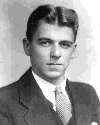
|
Reagan spent WW2 in the safety of Culver City. His
youthful picture shows the appearance of a determined actor. |







